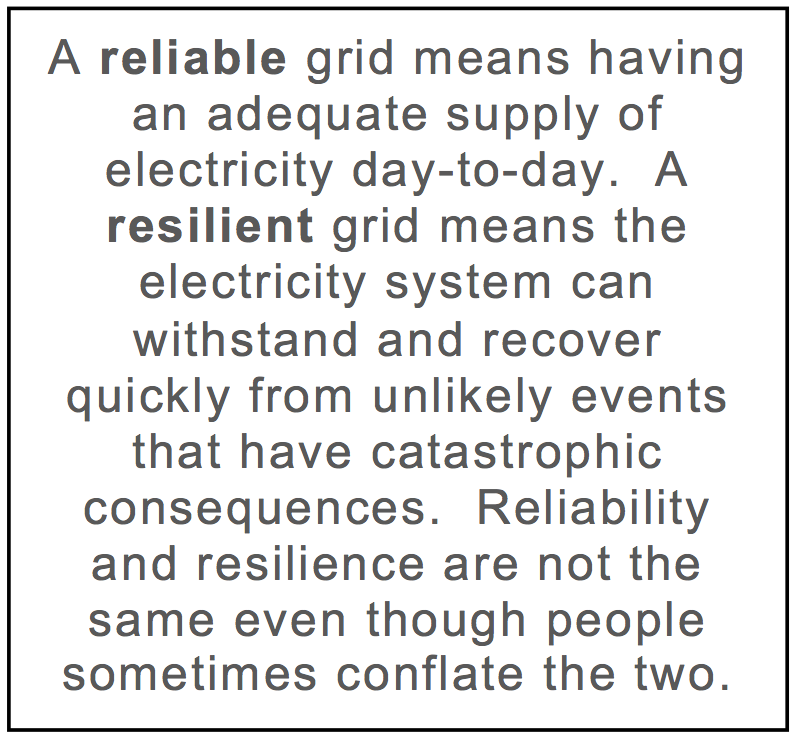NERC study examines whether too much natural gas
could threaten the nation’s electricity grid.
Based on current projections, natural gas is expected to play a large role in America’s electricity future. By 2030, natural gas could provide almost 40 percent of the nation’s electricity supply, more than any other source of electricity.[i]
So what, you might ask yourself?
The electricity grid’s increasing dependence on natural gas, combined with the retirement of coal-fueled and nuclear power plants, have raised serious questions as to whether these trends may be a threat to the reliability and resilience of the nation’s electricity grid.

These concerns led the Department of Energy to propose the “Grid Reliability and Resilience Pricing Rule” a few weeks ago.[ii] The rule has helped trigger an important debate about the value of fuel-secure electricity sources that ensure our electricity supply is both reliable and resilient.
Coal-fueled power plants provide fuel security because they have a large supply of coal stockpiled at each plant. Over the past five years, coal-fueled power plants have averaged up to 83 days of coal stockpiled on site.[iii] This means these plants can operate for more than two months, if necessary, without having to bring in more coal to produce electricity. Unfortunately, a large part of the nation’s coal fleet ― more than 600 coal-fueled electric generating units in 43 states ― has shut down or has plans to shut down.[iv]
Recently, the North American Electric Reliability Corporation issued an assessment of the potential threats to the electricity grid posed by disruptions to natural gas pipelines and other parts of the natural gas delivery system.[v] The report is important because NERC’s mission is to ensure the reliability of the nation’s bulk power system.
NERC’s report is a sober warning by experts about potential problems with natural gas. The report lists 17 “vulnerabilities” that could interrupt the delivery of natural gas to power plants.[vi] It’s worth noting that these are only “some” of the things that could go wrong.[vii] Consider a few of NERC’s findings.
-
The risk with just-in-time gas delivery Natural gas-fired power plants rely on “just in time” deliveries of fuel because natural gas cannot be stored easily at power plant sites.[viii] (Coal-fueled power plants have enough coal on site to last for two or more months.) NERC points out that in many cases, several gas-fired power plants are served by the same natural gas pipeline. NERC identified 11 major interstate gas pipeline systems that are collectively responsible for the delivery of natural gas to more than half the nation’s gas-fired power plants.[ix] A serious problem with any of these pipeline systems could interrupt gas deliveries to multiple power plants and spell trouble for the grid. To assess potential grid impacts, NERC identified groups of natural gas-fired power plants that could be at risk if gas is interrupted. NERC’s analysis found that three fourths of these gas-fired plants could cause blackouts (“voltage stability issues” in the report) if their natural gas supply is interrupted.
-
Not being prepared for gas disruptions NERC surveyed Reliability Planning Coordinators—the experts in charge of evaluating reliability threats—about their preparedness in the event natural gas supplies were disrupted. More than two-thirds of those surveyed either had done no analysis or did not respond to the survey.[x] The fact that so many reliability planners were not able to give a definitive answer about their preparedness for the possibility of gas disruptions is cause for concern.
-
Lack of dual fuel as a backup for gas Having a backup fuel source (either fuel oil or diesel) stored on site at gas-fired power plants could mitigate risks with natural gas deliveries because it would provide insurance in case of gas disruptions. However, NERC indicated that only 27 percent of natural-gas–fired generating capacity built over the past two decades has dual-fuel capability.[xi] This means that some 275,000 megawatts of gas-fired generating capacity lack dual-fuel capability.[xii] Even for plants with dual-fuel capability, environmental requirements can restrict operations if it becomes necessary to use either oil or diesel as a backup source of electricity.[xiii]
NERC offered 10 recommendations to address these and other concerns.[xiv] The recommendations will take time to implement. In the meantime, we need to be wary about increasing reliance on natural gas and concerned about the retirement of fuel-secure electricity sources, especially coal-fueled power plants.
[i] EIA AEO 2017.
[ii] 82 Fed. Reg. 46,940, Oct. 10, 2017.
[iii] EIA, Electricity Monthly Update.
[iv] ACCCE, “Retirement of U.S. Coal-fired Generating Units,” October 2017.
[v] NERC “Special Reliability Assessment: Potential Bulk Power System Impacts Due to Severe Disruptions on the Natural Gas System,” November 2017. (“NERC Report”)
[vi] NERC Report, Chapter 8 (“Other Contributing Factors to Natural Gas Disruptions”), page 25.
[vii] “A list of some of the potential natural gas system vulnerabilities includes the following …” (emphasis added). NERC Report page 25.
[viii] NERC Report page 1.
[ix] NERC Report page 4.
[x] NERC Report page 39.
[xi] NERC Report page 10.
[xii] EIA Electric Power Monthly, October 2017, and EIA Electric Power Annual 2001.
[xiii] NERC Report page ix.
[xiv] NERC Report pages ix and x.
